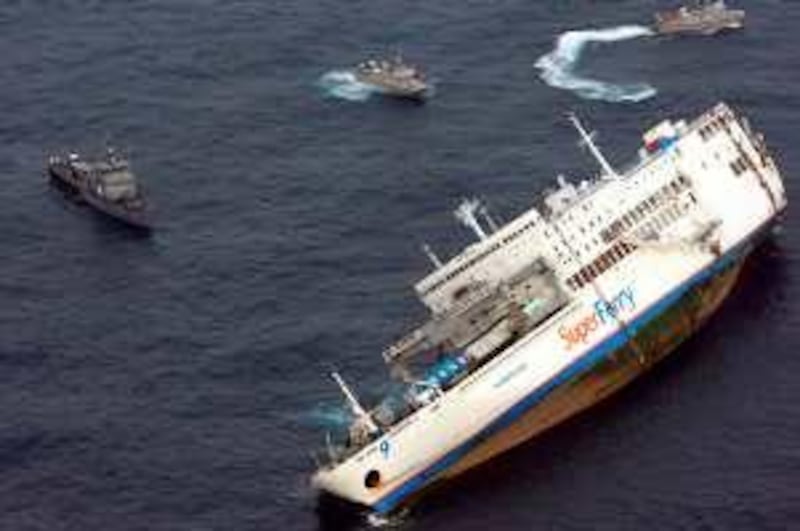MANILA // The Philippine Marine Board of Inquiry has ended its investigation into the sinking of a ferry in September and, although the findings are being kept under wraps, the recommendations are likely to provide further embarrassment to a country which supplies the officers and crews for more than a third of the world's maritime fleet.
The 7,268-tonne SuperFerry 9, owned by Aboitiz Transport System Corp, capsized off the coast of Zamboanga del Norte in the southern Philippines in relatively calm waters. The accident, in which just 10 of the ferry's 900 passengers died, turned the spotlight back on to the woeful decline of the country's domestic shipping industry. During the inquiry the board heard that one of the roll-on roll-off passenger ship's side doors may have been left open when it left Iloilo for the trip to Manila. Other witnesses claimed the ship's cargo moved, putting the ship off balance.
The head of the inquiry, Rear Adm Alejandro Flora, said the board's findings were submitted to the coastguard commandant, Adm Wilfredo Tamayo. "We can't reveal our findings," Adm Flora said. "We have made a number of recommendations, but now it is up to the coastguard to look at them and make recommendations. Until that happens we cannot say anything." Despite the relatively low casualty rate, the accident has revived memories of the 23,824-tonne Princess of the Stars, which sank during a typhoon in the central Philippines last year with the loss of more than 700 people.
Some 16 months after the tragedy, Sulpicio Lines, the owner of the vessel, is still barred from carrying passengers although freight operations were allowed to continue just weeks after the sinking. Sulpicio Lines, one of the country's largest shipping companies, is the most controversial, given its long list of shipping accidents in the Philippines. It was the owner of the Dona Paz, which sank in 1987 with the loss of at least 5,000 people, making it the biggest shipping disaster ever. Years later the company was cleared of criminal liability.
Two sister ships of the Dona Paz sank in storms in 1988 and 1998, with the loss of more than 500 lives. The shipping line was again cleared. Nelson Ramirez, the chairman and president of the United Filipino Seafarers, said if he had his way Sulpicio Lines would never be allowed to carry passengers again. "In December it will be 22 years since the Dona Paz tragedy. The ship carried between 3,000 and 5,000 people. The manifest said 1,400. No one will ever know how many died. But since then we have witnessed a spate of sea tragedies and our maritime industry flounders like a ship without a rudder," Mr Ramirez said.
"The recent sinking of SuperFerry 9 was unfortunate as Aboitiz has a good record for both passengers and cargo - it is one of the better shipping lines in this country," he said. "Sulpicio on the other hand has an appalling record. Their ships are old, their crews are poorly trained and they don't care." Many commentators in the Philippines have described the local inter-island passenger ships as "floating coffins".
The Philippines has about 500,000 certified officers and seamen, of which 300,000 now work on foreign ships overseas. "Many of them who can't get jobs overseas prefer to do something else rather than sail local waters - they know the risks," Mr Ramirez said. "The biggest reason is economics. The salary of an entry level officer in international vessels is even more than the salary of a captain in local vessels."
A master mariner or a chief engineer can earn between US$3,500 and $10,000 (Dh12,900-Dh36,700) a month on foreign vessels, compared with jobs on local ships where they could earn between 20,000 and 120,000 Philippine pesos (Dh1,500 to Dh9,300) a month, Mr Ramirez said. Mr Ramirez said many of the local vessels were substandard and did not meet international standards of seaworthiness. "The tragedy with shipping accidents in this country is that it is the poor who use ships to travel between the islands. Those who have money prefer to fly."
Sulpicio Lines is still barred from carrying passengers but it was given the all clear to carry cargo within weeks of the Princess of the Stars going down. A marine board of inquiry later found the sinking was an "act of God" as the ship's captain, who also died, sailed into a typhoon. Mr Ramirez described it as an "act of stupidity". Reports of overloaded vessels and inaccurate passenger manifests are not uncommon. When ferries go down, operators rarely bear the brunt of hefty claims from victims' families. Inquiries and court cases can drag on for years, but slide quickly from public view.
The families of the Princess of the Stars' victims were offered compensation of 200,000 Philippine pesos each and by accepting the compensation forfeited the rights to any further legal action. "Most of them are poor and not in a position to mount a legal action for damages," said Harry Roque, a lawyer who represented some families of the Dona Paz victims who sought higher compensation in the courts.
foreign.desk@thenational.ae





